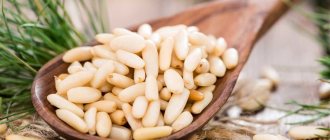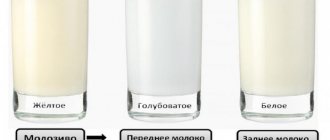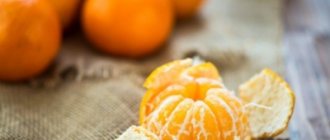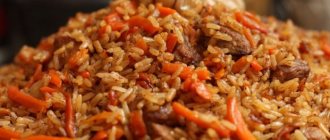≡ December 25, 2020 Category: Children
Hundreds of mothers of newborn babies sooner or later think about how to increase lactation. After all, it’s no secret that breast milk is best suited for feeding babies, especially in the first months of life. Most conscientious mothers strive to breastfeed their babies for as long as possible, but, in spite of everything, the day comes when the milk gradually decreases, and the baby, accustomed to or in need of breastfeeding, becomes restless and capricious.
From this article you will learn:
- Why does breast milk lactation decrease?
- How to increase lactation by eating right.
- How to increase and maintain lactation.
First, you need to calm down and not panic, urgently transferring the child to adapted formulas, of which there is a huge selection in stores, because the risk of losing breast milk will only increase significantly. And, despite the wide range of adapted formulas, not one of them compares with breast milk in terms of its benefits, not to mention the allergic reactions that adapted formulas can often cause. Only women's breast milk contains substances that are so vital for the full development of the baby's growth, for the development of the brain, for the formation of the nervous system. And it is mother’s milk that creates a solid foundation for the baby’s immunity.
In addition, in the first months of a child’s life, there is only one mother, and breastfeeding helps to establish the close psycho-emotional connection that is so necessary for the baby. Yes, you might also be interested in an article about how to bathe a newborn baby.
Note: From the age of 6 months, the child’s father comes into the child’s field of vision and the connection with the mother begins to weaken, and somewhere around the age of 12 months, the child begins to let his grandparents approach him.
Useful qualities and harm of walnuts
When a nursing mother wants to treat herself to a nut, it is worth considering whether walnuts can be consumed while breastfeeding, whether they are harmful for the baby and for the woman who recently gave birth. If we talk about walnuts while breastfeeding, there are three bad news for lovers of this delicacy:
- This product is very high in calories. If you abuse it, it will be very difficult to get rid of the kilograms gained during pregnancy. There’s no need to add too much, because it’s so difficult to limit yourself to a few kernels when they are so tasty.
- Most of the calories in nuts come from lipids. It can be said that Greek kernels consist almost entirely of fat, and this must be taken into account by those who calculate the amount of nutrients in the diet.
- The essential oil contained in nuts is a strong allergen. During breastfeeding, harmful substances easily penetrate into the milk, and from there into the baby’s blood. It is impossible to tell in advance whether a nursing mother can use this product until you try it. However, if one of your relatives has a predisposition to allergies and diseases such as asthma, it is better not to risk it and hold off on introducing kernels into the diet. In addition, the child’s reaction may not occur immediately after the mother eats food, but may have a cumulative effect and appear at the most unexpected moment.
How many calories and fats will enter the body if you eat 100 g of kernels:
- Kcal - 648;
- proteins, g - 15.4;
- carbohydrates, g - 10.2;
- fats, g - 65.
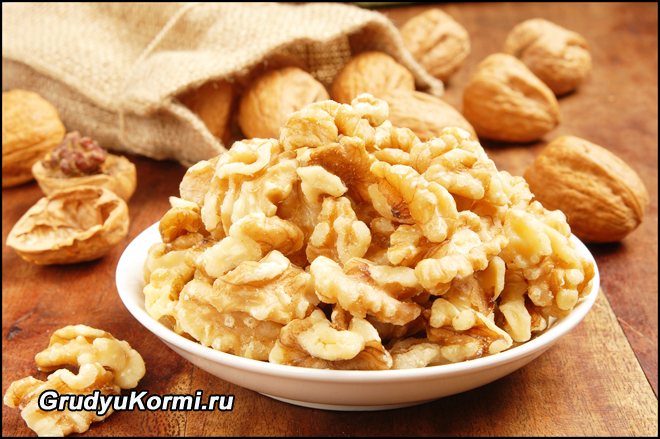
In addition, the fruits contain: But if you look carefully at the composition, it becomes clear that in the absence of allergies, nursing mothers need and can eat walnuts. There are not many carbohydrates in them, which means that with moderate consumption there will be no harm to the figure. The second good news: walnut oil is very healthy, so you can eat it safely while breastfeeding, taking moderation.
- complete protein;
- unsaturated fatty acids;
- essential amino acids;
- provitamins A;
- essential oils;
- tannins;
- vitamin C.
If mom eats a handful of nuts a day, her immunity will be strengthened and the incidence of colds will decrease. Greek nuts are useful for anemia, liver diseases, pathologies of the cardiovascular system, and gastrointestinal disorders. The oil protects blood vessels from “bad” cholesterol and fights the deposits of atherosclerotic plaques. The beneficial effect on the baby’s body is expressed in calming his nervous system and sound, healthy sleep.
Thus, during lactation, nursing mothers can eat walnuts, the main thing is to make sure that there are no negative reactions and not to get too carried away with this tasty but high-calorie product.
Prevention
To improve lactation and prevent conditions leading to loss of breast milk, certain rules should be followed:
- eat regularly and properly;
- Allow sufficient time for sleep at night and, if possible, rest at night;
- take daily walks, which are beneficial for both mother and baby;
- take multivitamins if necessary;
- avoid stressful situations.
There are many ways and recommendations on how to increase the milk supply of a nursing mother. To do this, you can use drugs from the pharmacy chain, and recommendations from traditional medicine healers. The most important thing is to find out the cause of the lactation disorder and eliminate it, and to do this you need to consult your doctor or lactation consultant.
Nuts in the diet
Since we found out that a nursing mother can eat walnuts, we need to determine the permitted portions. Usually this is 4 - 5 nucleoli per day and better in the first half of the day. You should not eat them for breakfast or lunch, combining them with other foods. Let it be a light snack in a separate meal. You can take not pure nuts, but a nut mixture, which includes hazelnuts, cashews and others, but not peanuts.
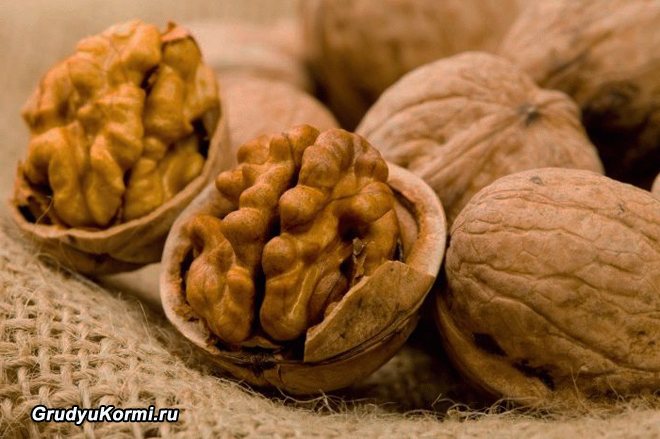
Which nuts should you avoid:
- fried;
- ground into a paste with sugar, honey (urbech) or chocolate;
- added to jams and confectionery products.
In this form, nuts will not bring any benefit; on the contrary, they will cause such troubles as intestinal colic.
But in savory dishes, the walnut becomes a real “zest”, giving the food a specific taste and aroma. Add kernels to beet salad, make satsivi, Georgian nut soup with chicken, and enjoy your favorite nuts without worry.
Eg:
- Grate boiled beets (3 medium-sized root vegetables) on a coarse grater, lightly fry 80 g of kernels in a dry frying pan and chop into a salad. You can season with any vegetable oil, including walnuts, or low-fat sour cream. Additives such as mayonnaise, sugar, garlic are undesirable during breastfeeding.
- Boil the chicken pieces in salted water. While the bird is cooking, make a sauce: grind 400 g of walnuts, add a fried onion to the mixture, beat in an egg and dilute everything with chicken broth. Salt, spices, herbs - to taste. Whisk the sauce to the consistency of liquid sour cream, then pour it over the cooked chicken, boil and leave to steep for at least 3 hours. Satsivi is served cold.

Also have walnut oil on your table. You can buy it in the store and use it to add to salads and side dishes. There is no need to fry it, or pour it into dishes when cooking; the value of this “elixir” is manifested only in its natural form. In addition to its rich vitamin and fatty acid composition, this oil has the ability to gently loosen stools, which is especially important for women after childbirth and infants who have problems with constipation.
General tips for lactation
Any doctor or consultant, when a nursing mother approaches a problem of how to increase lactation, will immediately tell you to pay attention to your diet. It should be complete and nutritious, but it should not contain a huge amount of calories. Since the extra calories will remain on the mother’s sides, and not on the baby’s cheeks.
So forget the old rule of “eating for two.” You need plenty of protein, the right carbohydrates and some fat. In this case, the food will be of high quality, and there will be enough for the baby and mother. The mother's diet must include:
- meat;
- fish;
- eggs;
- milk;
- dairy products;
- cottage cheese;
- cheese;
- vegetables;
- fruits.
But you should forget about smoked meats, sweets, foods that can cause allergies, and fast foods.
Be sure to drink clean, still water. A nursing woman should take at least 2.5 liters of fluid. However, this volume does not include dairy products and juices.
A newborn should be fed on demand. He will build his own daily routine, but first you need to adapt to each other, teach the baby to suck properly, and find the correct and comfortable feeding positions for the two of you. Night feedings are especially important in the development of milk lactation. From 3 to 8 am is the time to set the milk volume for the whole day. Therefore, try to feed at least once during this period.
It is also necessary to hug and hold the baby in your arms as often as possible. All the “horror stories” about him being tame are just myths. Once he learns to walk and crawl, he won't need it. And now he needs the warmth and care of his mother.
Her only concern should be the newborn. Therefore, consult with your husband about what household responsibilities he can take on while the child is still very small.
Walnuts as a lactogenic product
Traditional medicine recommends eating walnuts to increase lactation. It is a common misconception that certain foods will increase milk production if the mother really has little milk. In fact, neither the kernels, nor the shell partitions, nor the oil have any effect on the functioning of the mammary glands. In order for milk to flow well, a woman needs to drink more, massage and warm compresses to dilate the ducts, and most importantly, feed the baby as often as possible, especially at night. Only stimulation by sucking increases the release of a special hormone - prolactin, which is responsible for the secretion of the mammary glands.
However, consuming walnuts for lactation may still be justified if a woman’s milk is too “thin.” A high-calorie product will increase the fat content as much as possible, making the baby's food thicker and more nutritious, thanks to which he will be filled faster and remain hungry longer. And as you know, a well-fed baby means a calm and happy mother.
To prevent walnuts from being harmful, you should not eat them in large quantities or as part of sweets. Only moderation and careful observation of the baby’s reaction will allow a nursing mother to safely enjoy delicious nuts and get the maximum benefit from them.
The main reasons for the problem
A true condition in which insufficient milk production occurs in the mammary glands immediately after the birth of the baby is quite rare. This phenomenon is called hypogalactia. According to statistics, only 5% of all women may have it. With this pathology, milk disappears after childbirth due to severe hormonal disorders in the body.
In the vast majority of cases, the reasons that there is little milk in the breast are as follows:
- lack of desire to breastfeed on the part of the mother herself;
- violation of the baby’s routine and rare feeding of the baby to the breast;
- irrational or insufficient nutrition of a woman;
- stress and unfavorable home environment;
- An attempt to supplement the baby's feeding with formula milk.
Sometimes breastfeeding mothers may experience a decrease in milk supply for no apparent reason. This happens around 4-6 weeks of a baby’s life and repeats at the seventh and eighth weeks.
The so-called lactation crises are temporary and appear during the period when the baby needs to increase the amount of food for the rapidly growing organism.
At these moments, it is very easy to make a common mistake during the development of a milk crisis - trying to introduce complementary foods or artificial formula, which will lead to the final loss of milk. What to do in this case? You just need to overcome the first crisis and lactation will improve.
Composition of breast milk
What does milk consist of? Breast milk contains a unique complex of vitamins, microelements, proteins and carbohydrates (in an easily digestible form). Moreover, the composition of this valuable nutrition changes not only depending on the age of the child, but also throughout each feeding. All the most useful things go to the baby.
- The baby receives early milk as soon as he begins to eat. It looks watery and “blue”. It makes up 90% of all milk. Thanks to it, the baby quenches his thirst, because early milk contains a lot of water and vitamins and minerals dissolved in it.
- Later, milk appears at the end of feeding. It is the most caloric: more than half of its composition is fat. Therefore, late milk is opaque and white. It gives energy.
- It is important that the baby receives both early and late milk. To do this, apply it to one breast and wait until it is completely saturated. If you notice that the baby has drunk everything, put him on the other breast. In this case, start the next feeding with her.
- Do not remove the baby after he has nursed for 15-20 minutes. Later, milk is usually sucked intermittently. The child wants to take a break, because this milk is thicker. It takes a little effort.
Checking prolactin levels

An analysis for the content of this biologically active substance in the blood is taken on any day, and the day of the menstrual cycle is absolutely not important, because its concentration differs in different phases of the menstrual cycle.
In some cases, for convenience, tests for other hormones are combined with an analysis for prolactin levels in the first days of the menstrual cycle. In such cases, it is best to donate blood between the second and fifth or fifth and eighth days of the cycle. Blood should be donated in the morning, on an empty stomach, a few hours after sleep, because the time of day can also affect the result (most often, the concentration decreases upon awakening). It is best to take the analysis twice, preferably in different laboratories, in order to compare them and perform the correct interpretation.
Periods of lactation crisis: when the baby does not have enough milk
Most often, a crisis occurs 3-6 weeks after the birth of a child and can repeat at 1 month, then at 3, 4, 7. For young mothers, this happens in different ways: some do not feel a decrease in lactation, for others, crises may deviate for a month from "graphic". The baby's well-being and behavior will tell you that he does not have enough milk.
Weigh the baby. If he has gained less than 500 g in a month and you notice that the baby has become lethargic and capricious, take action.
Take the test. Do not put disposable diapers on your baby for 24 hours and breastfeed him exclusively. Find out how many times he wet his pants. Moreover, if the wet spots were small, count two as one. In total you should get at least eighteen. Otherwise, increase your lactation!
